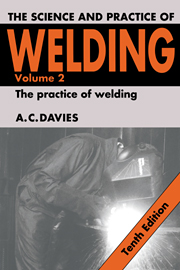Book contents
- Frontmatter
- Contents
- Preface
- 1 Manual metal arc welding
- 2 Gas shielded metal arc welding
- 3 Tungsten electrode, inert gas shielded welding processes (TIG), and the plasma arc process
- 4 Resistance welding and flash butt welding
- 5 Additional processes of welding
- 6 Oxy-acetylene welding
- 7 Cutting processes
- 8 The welding of plastics
- Appendixes
- City and Guilds of London Institute examination questions
- Index
5 - Additional processes of welding
Published online by Cambridge University Press: 11 May 2010
- Frontmatter
- Contents
- Preface
- 1 Manual metal arc welding
- 2 Gas shielded metal arc welding
- 3 Tungsten electrode, inert gas shielded welding processes (TIG), and the plasma arc process
- 4 Resistance welding and flash butt welding
- 5 Additional processes of welding
- 6 Oxy-acetylene welding
- 7 Cutting processes
- 8 The welding of plastics
- Appendixes
- City and Guilds of London Institute examination questions
- Index
Summary
There has been a great increase in the number of automatic processes designed to speed up welding production. Automatic welding gives high rates of metal deposition because high currents from 400 to 2000 A can be used, compared with the limit of about 600 A with manual arc welding. Automatic arc control gives uniformly good weld quality and finish and the high heat input reduces distortion and the number of runs for a given plate thickness is reduced. Twin welding heads still further reduce welding time, and when used, for example, one on each side of a plate being fillet welded, distortion is reduced. The welding head may be:
Fixed, with the work arranged to move beneath it.
Mounted on a boom and column which can either be of the positioning type in which the work moves or the boom can traverse at welding speed over the fixed work.
Gantry mounted so that it can traverse over the stationary work.
Self propelled on a motor-driven carriage.
The processes which have been described previously in this book, namely TIG, MIG and CO2 (gas shielded metal arc) with their modifications, are extensively used fully automatically. Heads are now available which, by changing simple components, enable one item of equipment to be used for MIG (inert gas), CO2 and tubular wire, and submerged arc processes.
- Type
- Chapter
- Information
- The Science and Practice of Welding , pp. 216 - 254Publisher: Cambridge University PressPrint publication year: 1993



